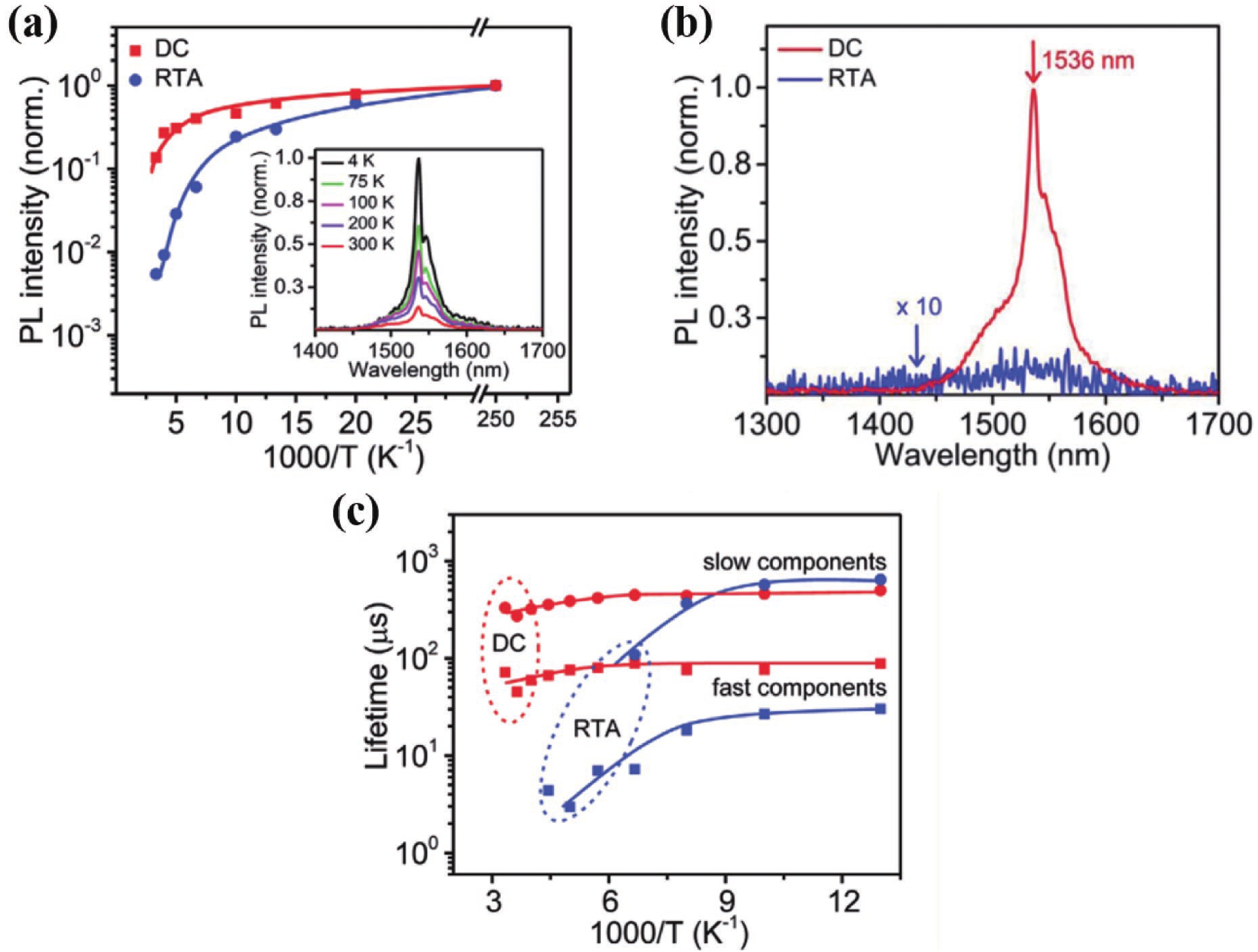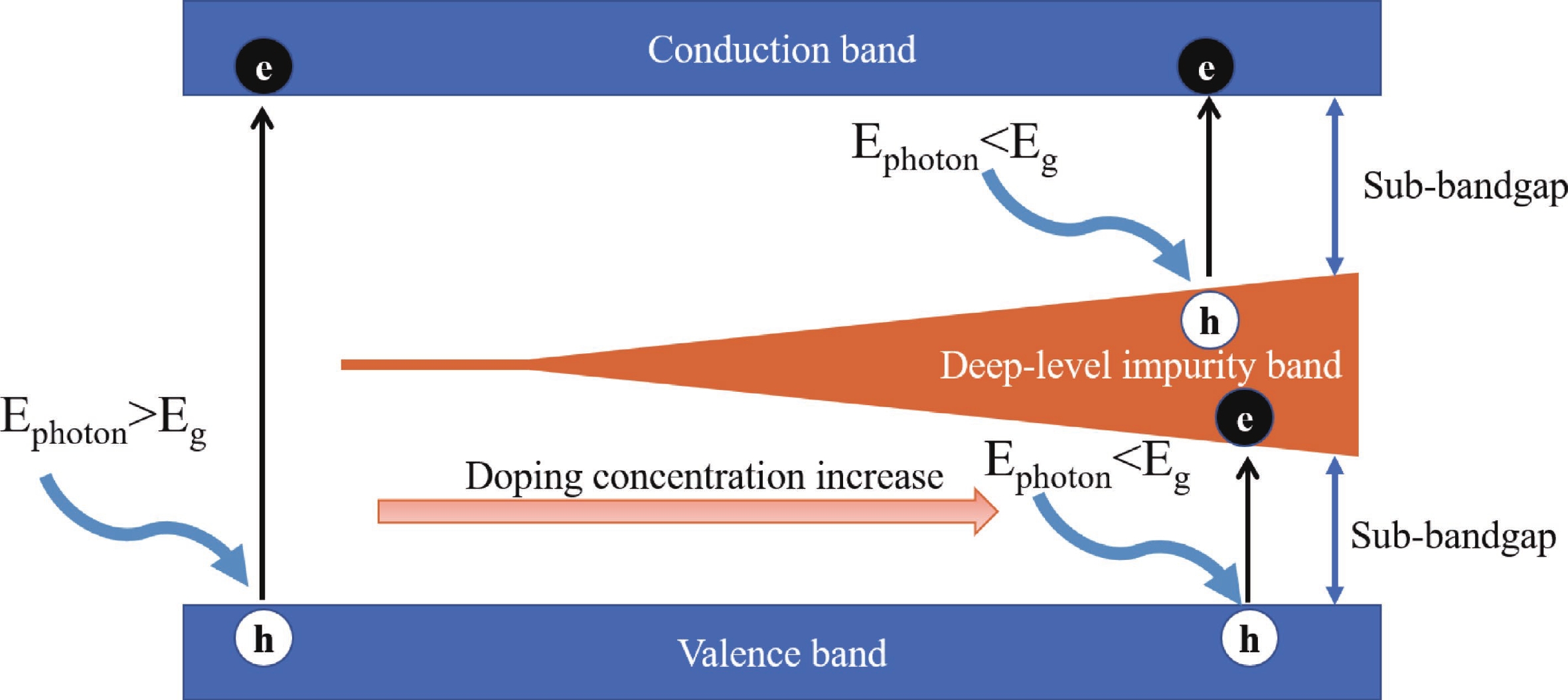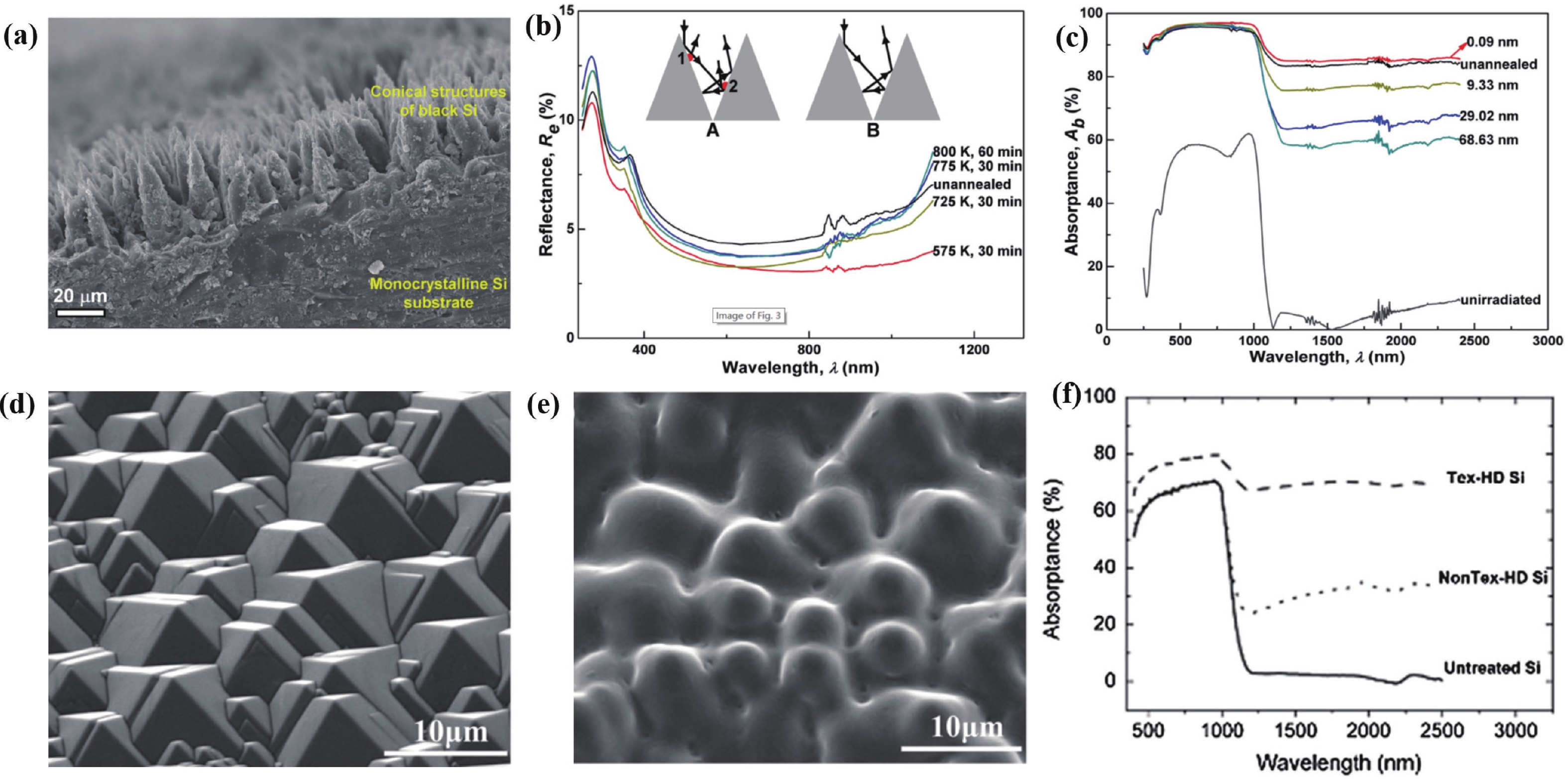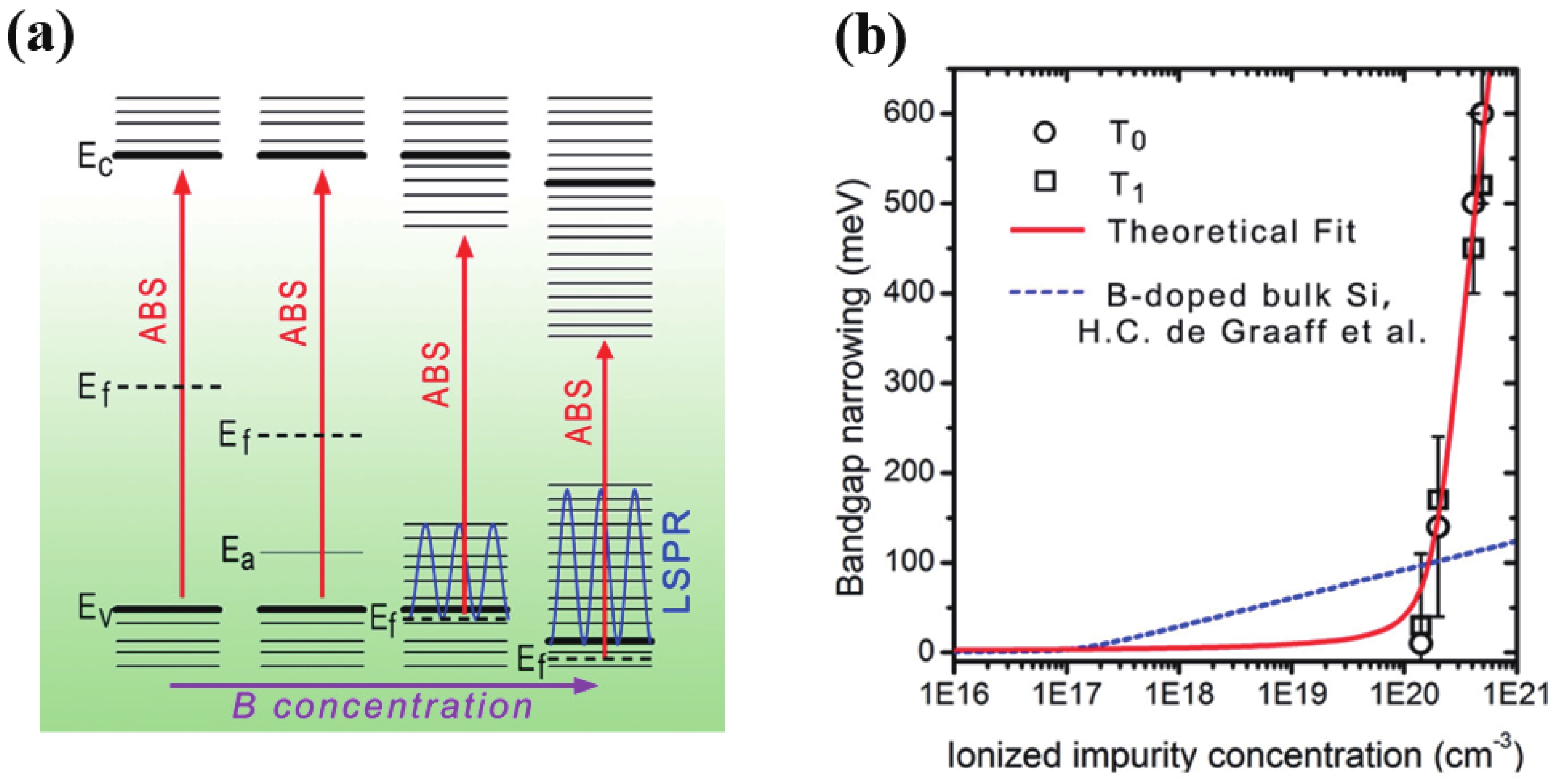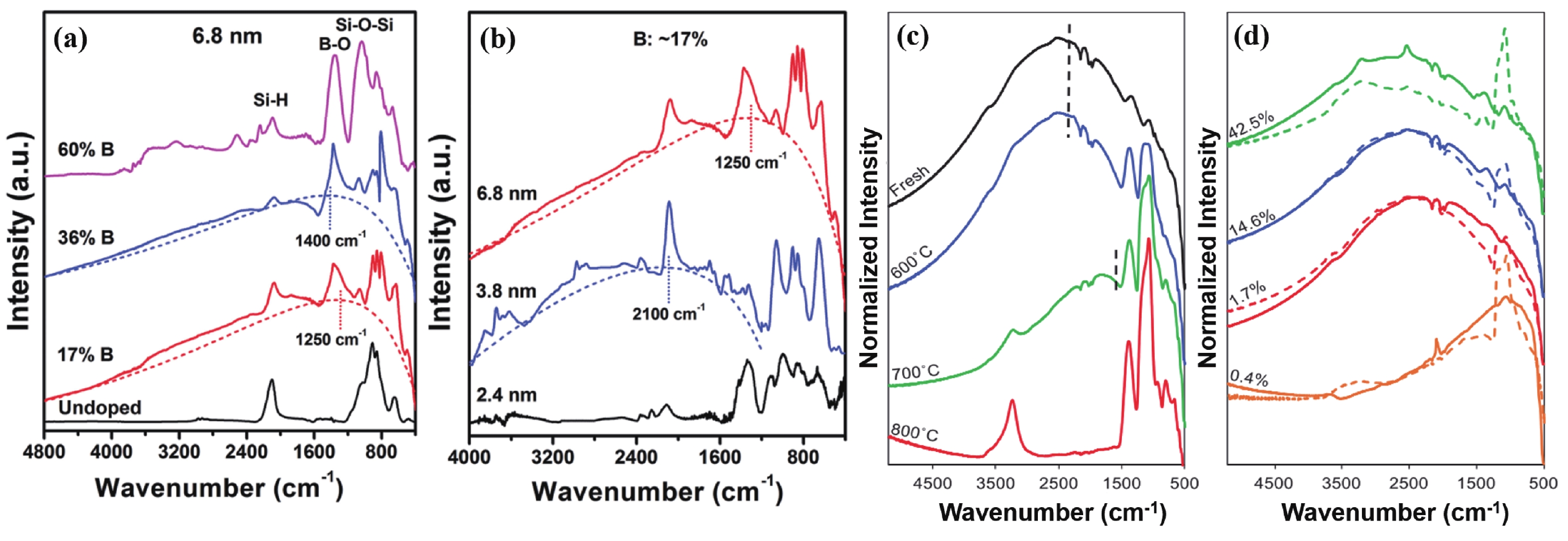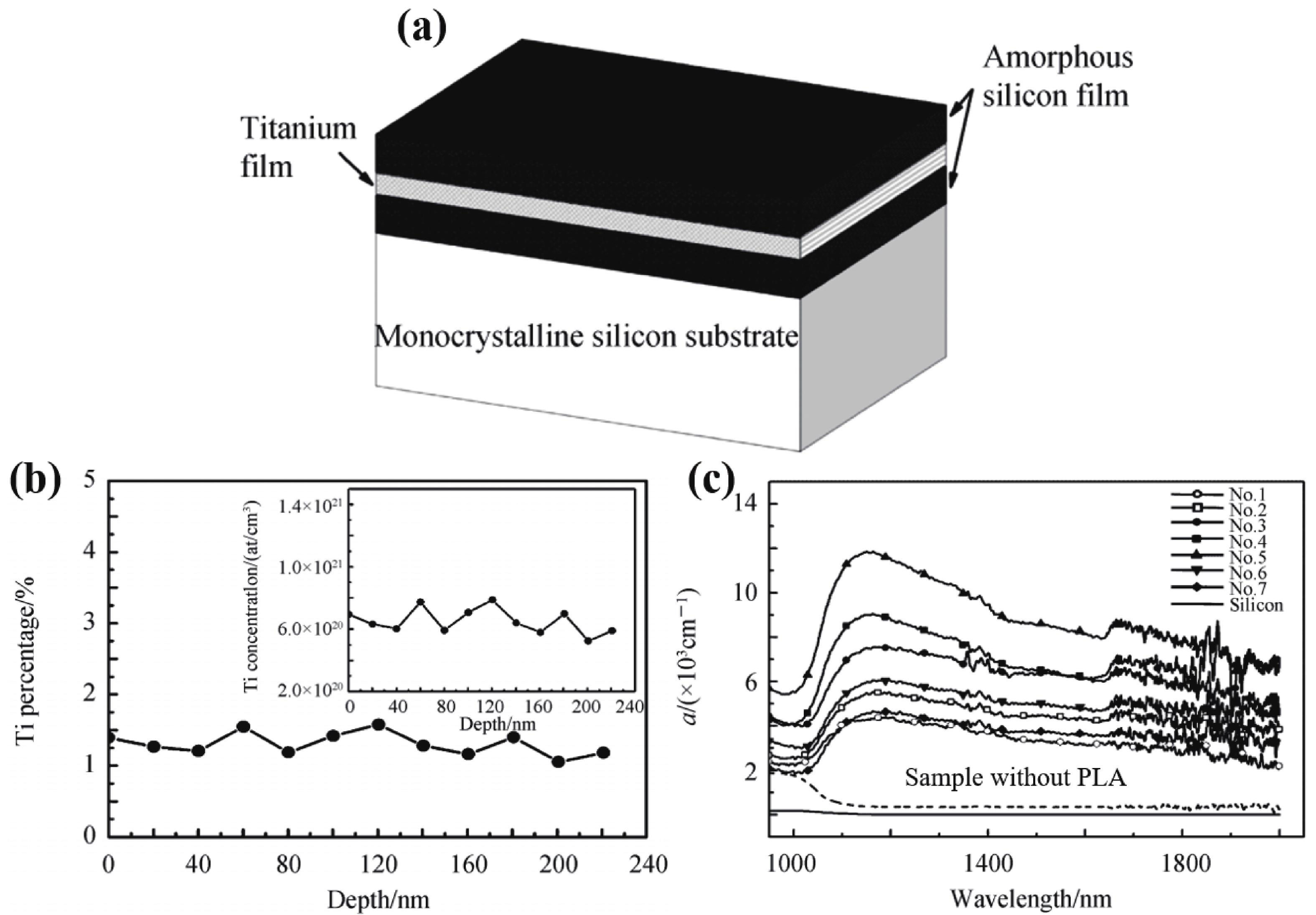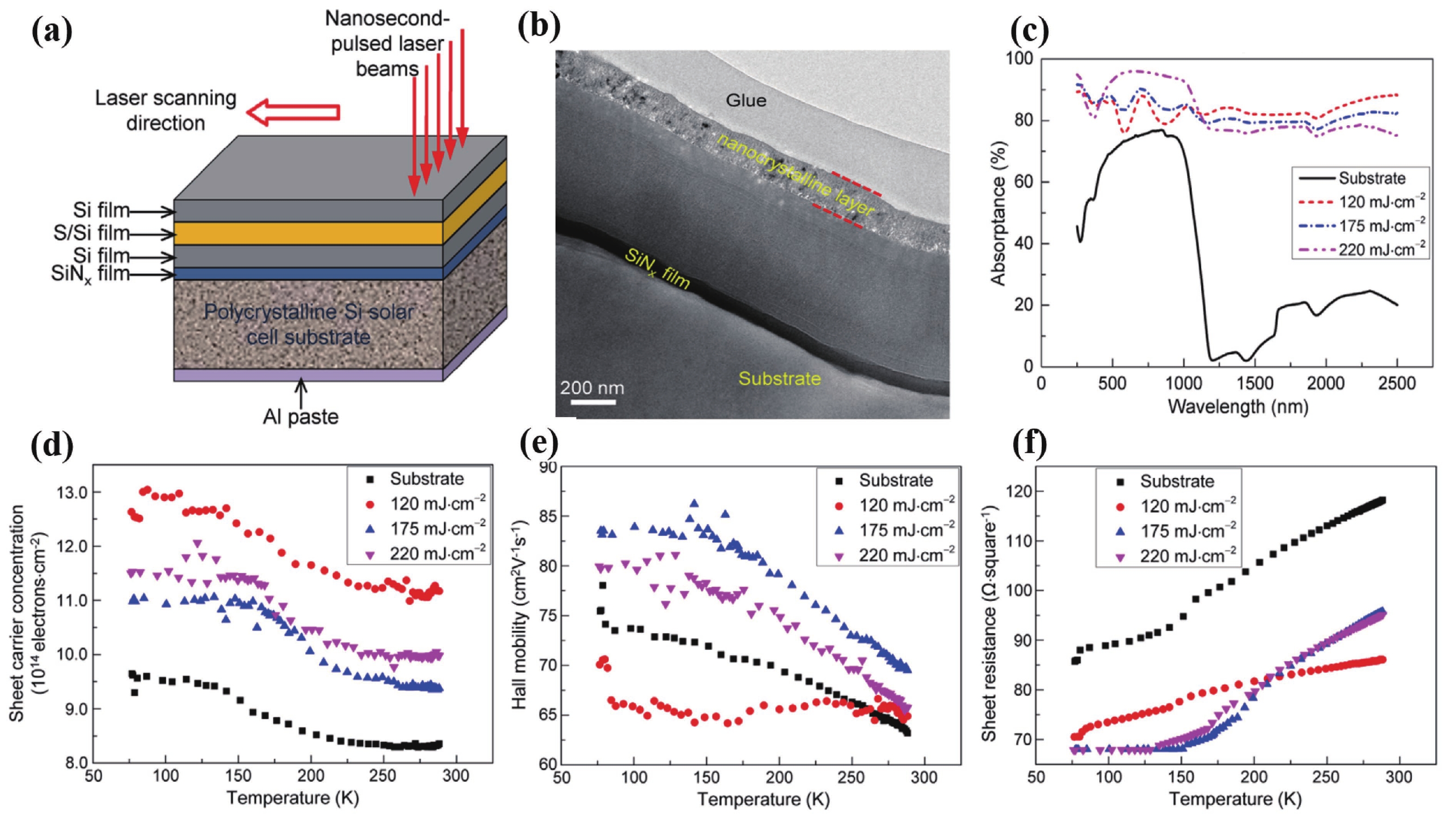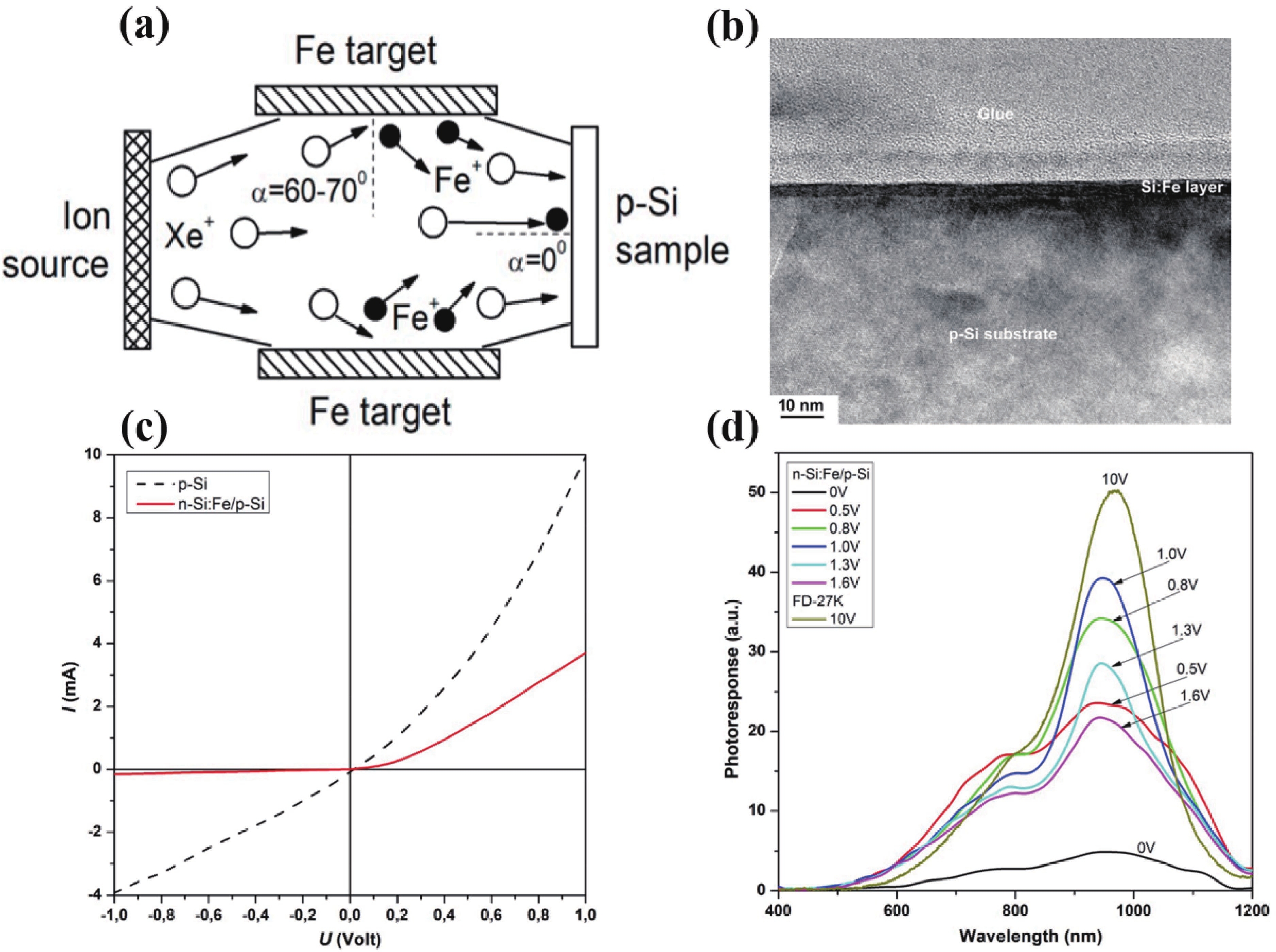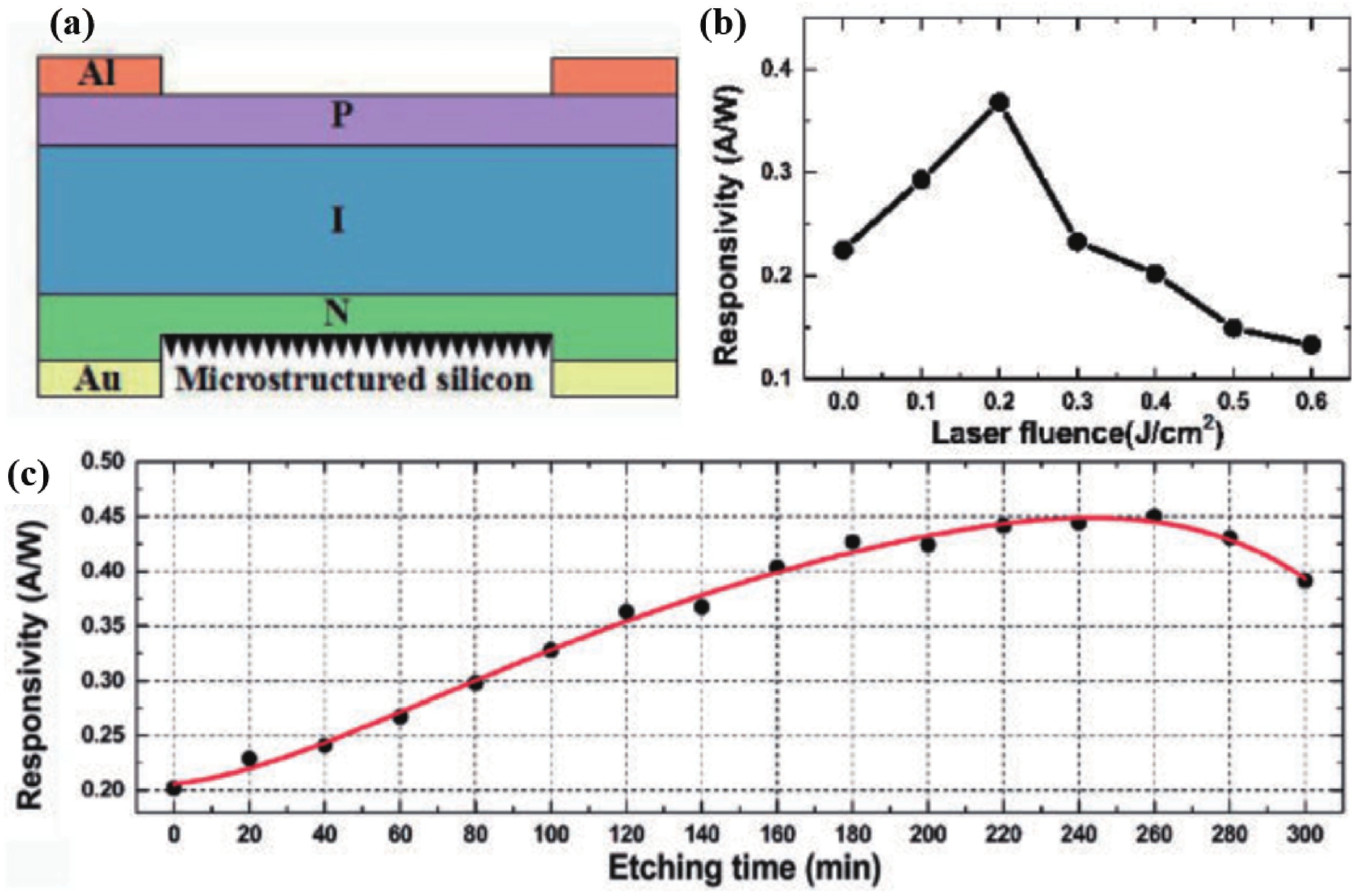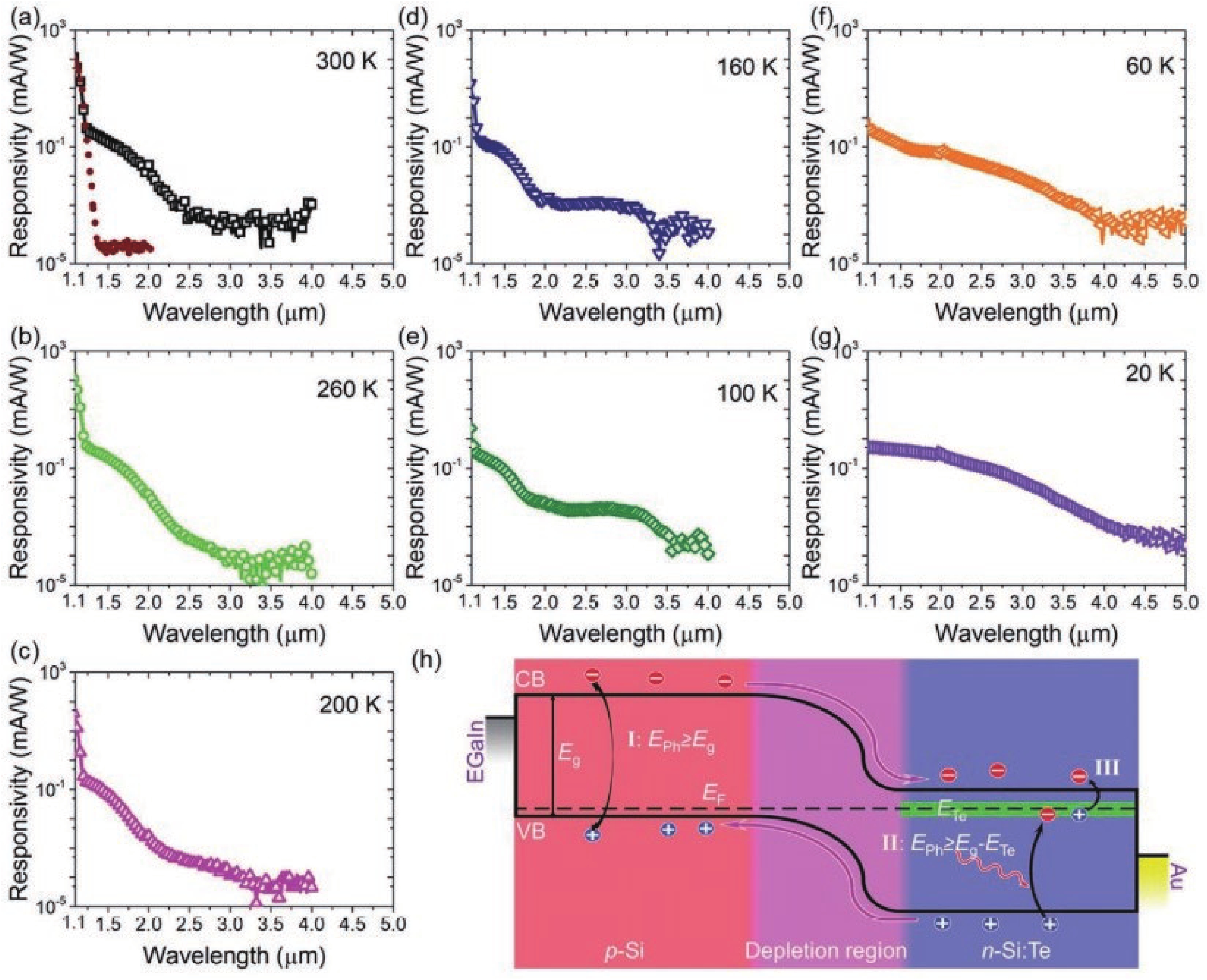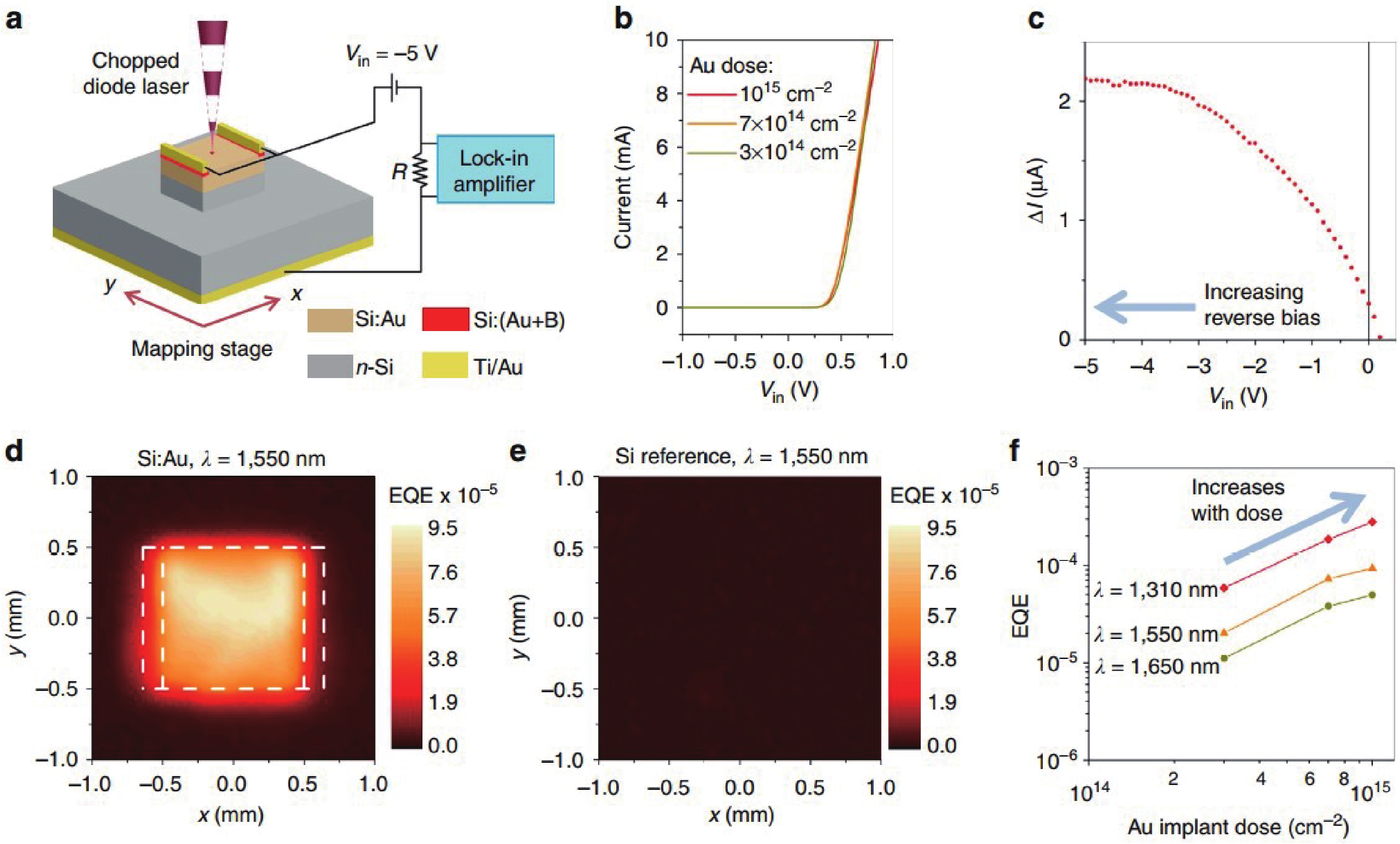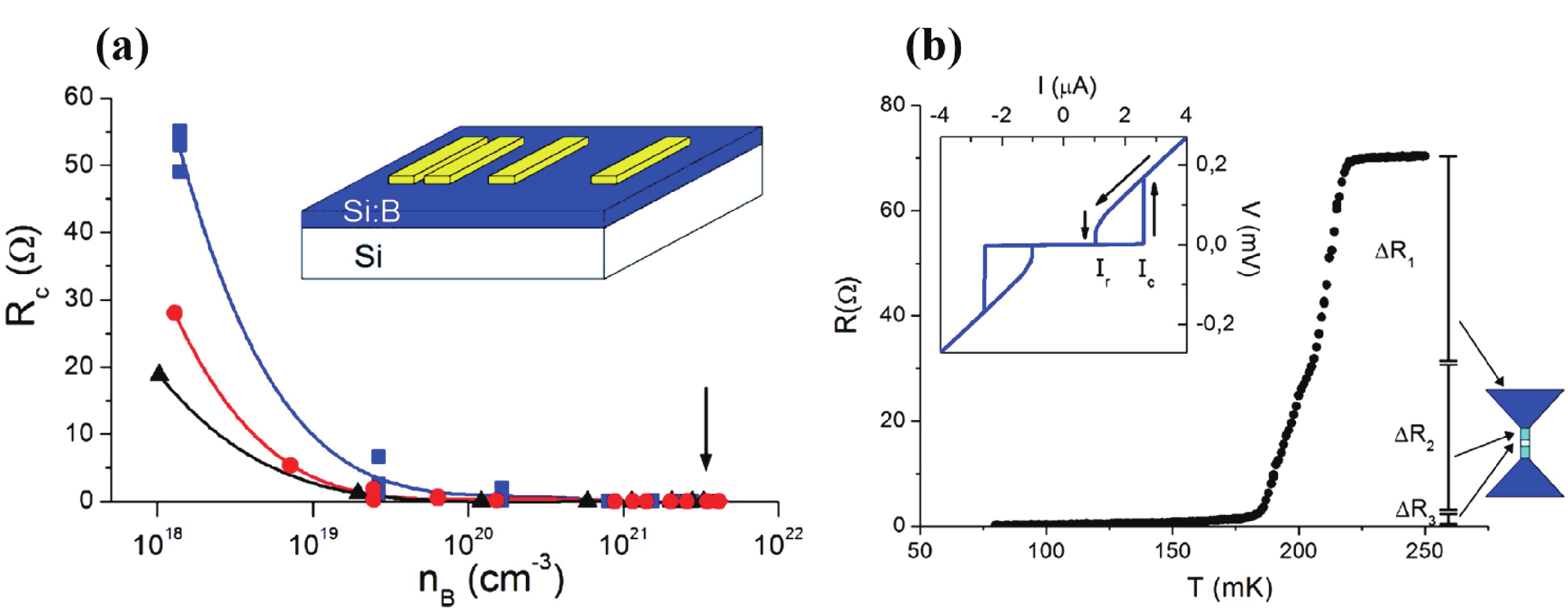| Citation: |
Zhouyu Tong, Mingxuan Bu, Yiqiang Zhang, Deren Yang, Xiaodong Pi. Hyperdoped silicon: Processing, properties, and devices[J]. Journal of Semiconductors, 2022, 43(9): 093101. doi: 10.1088/1674-4926/43/9/093101
****
Z Y Tong, M X Bu, Y Q Zhang, D R Yang, X D Pi. Hyperdoped silicon: Processing, properties, and devices[J]. J. Semicond, 2022, 43(9): 093101. doi: 10.1088/1674-4926/43/9/093101
|
Hyperdoped silicon: Processing, properties, and devices
DOI: 10.1088/1674-4926/43/9/093101
More Information
-
Abstract
Hyperdoping that introduces impurities with concentrations exceeding their equilibrium solubility has been attracting great interest since the tuning of semiconductor properties increasingly relies on extreme measures. In this review we focus on hyperdoped silicon (Si) by introducing methods used for the hyperdoping of Si such as ion implantation and laser doping, discussing the electrical and optical properties of hyperdoped bulk Si, Si nanocrystals, Si nanowires and Si films, and presenting the use of hyperdoped Si for devices like infrared photodetectors and solar cells. The perspectives of the development of hyperdoped Si are also provided.-
Keywords:
- silicon,
- hyperdoping,
- ion implantation,
- laser doping,
- photodetectors,
- solar cells
-
References
[1] Simmons C B, Akey A J, Mailoa J P, et al. Enhancing the infrared photoresponse of silicon by controlling the fermi level location within an impurity band. Adv Funct Mater, 2014, 24(19), 2852 doi: 10.1002/adfm.201303820[2] Pi X D. Doping silicon nanocrystals with boron and phosphorus. J Nanomater, 2012, 2012, 3 doi: 10.1155/2012/912903[3] Marri I, Degoli E, Ossicini S. Doped and codoped silicon nanocrystals: The role of surfaces and interfaces. Prog Surface Sci, 2017, 92(4), 375 doi: 10.1016/j.progsurf.2017.07.003[4] Wang M, Debernardi A, Berencén Y, et al. Breaking the doping limit in silicon by deep impurities. Phys Rev Applied, 2019, 11, 054039 doi: 10.1103/physrevapplied.11.054039[5] Sánchez K, Aguilera I, Palacios P, et al. Formation of a reliable intermediate band in Si heavily coimplanted with chalcogens (S, Se, Te) and group III elements (B, Al). Phys Rev B, 2010, 82, 165201 doi: 10.1103/physrevb.82.165201[6] Liu F, Prucnal S, Berencén Y, et al. Realizing the insulator-to-metal transition in Se-hyperdoped Si via non-equilibrium material processing. J Phys D, 2017, 50, 415102 doi: 10.1088/1361-6463/aa82f9[7] Olea J, González-Díaz G, Pastor D, et al. Electronic transport properties of Ti-impurity band in Si. J Phys D, 2009, 42, 085110 doi: 10.1088/0022-3727/42/8/085110[8] Dai P, Zhang Y, Sarachik M P. Critical conductivity exponent for Si:B. Phys Rev Lett, 1991, 66, 1914 doi: 10.1103/PhysRevLett.66.1914[9] Wang K F, Shao H Z, Liu K, et al. Possible atomic structures responsible for the sub-bandgap absorption of chalcogen-hyperdoped silicon. Appl Phys Lett, 2015, 107, 112106 doi: 10.1063/1.4931091[10] García-Hemme E, García-Hernansanz R, Olea J, et al. Far infrared photoconductivity in a silicon based material: Vanadium supersaturated silicon. Appl Phys Lett, 2013, 103, 032101 doi: 10.1063/1.4813823[11] Haberfehlner G, Smith M J, Idrobo J C, et al. Selenium segregation in femtosecond-laser hyperdoped silicon revealed by electron tomography. Microsc Microanal, 2013, 19, 716 doi: 10.1017/S1431927613000342[12] Luque A, Martí A, Antolín E, et al. Intermediate bands versus levels in non-radiative recombination. Phys B, 2006, 382, 320 doi: 10.1016/j.physb.2006.03.006[13] Wang M, Hübner R, Xu C, et al. Thermal stability of Te-hyperdoped Si: Atomic-scale correlation of the structural, electrical, and optical properties. Phys Rev Mater, 2019, 3, 044606 doi: 10.1103/physrevmaterials.3.044606[14] Zhou S, Pi X D, Ni Z Y, et al. Boron- and phosphorus-hyperdoped silicon nanocrystals. Part Part Syst Charact, 2015, 32, 213 doi: 10.1002/ppsc.201400103[15] Rowe D J, Jeong J S, Mkhoyan K A, et al. Phosphorus-doped silicon nanocrystals exhibiting mid-infrared localized surface plasmon resonance. Nano Lett, 2013, 13, 1317 doi: 10.1021/nl4001184[16] Wang K F, Qu S C, Liu D W, et al. Large enhancement of sub-band-gap light absorption of sulfur hyperdoped silicon by surface dome structures. Mater Lett, 2013, 107, 50 doi: 10.1016/j.matlet.2013.05.123[17] Sher M J, Lin Y T, Winkler M T, et al. Mid-infrared absorptance of silicon hyperdoped with chalcogen via fs-laser irradiation. J Appl Phys, 2013, 113, 063520 doi: 10.1063/1.4790808[18] Simmons C B, Akey A J, Krich J J, et al. Deactivation of metastable single-crystal silicon hyperdoped with sulfur. J Appl Phys, 2013, 114, 243514 doi: 10.1063/1.4854835[19] Yang W, Ferdous N, Simpson P J, et al. Evidence for vacancy trapping in Au-hyperdoped Si following pulsed laser melting. APL Mater, 2019, 7, 101124 doi: 10.1063/1.5124709[20] Bao J M, Tabbal M, Kim T, et al. Point defect engineered Si sub-bandgap light-emitting diode. Opt Express, 2007, 15, 6727 doi: 10.1364/oe.15.006727[21] Carey P G, Bezjian K, Sigmon T W, et al. Fabrication of submicrometer MOSFET's using gas immersion laser doping (GILD). IEEE Electron Device Lett, 1986, 7, 440 doi: 10.1109/EDL.1986.26429[22] Wen C, Shi Z Q, Wang Z J, et al. Zinc-hyperdoped silicon nanocrystalline layers prepared via nanosecond laser melting for broad light absorption. Opt Laser Technol, 2021, 144, 107415 doi: 10.1016/j.optlastec.2021.107415[23] Komarov F F, Nechaev N S, Ivlev G D, et al. Structural and optical properties of Si hyperdoped with Te by ion implantation and pulsed laser annealing. Vacuum, 2020, 178, 109434 doi: 10.1016/j.vacuum.2020.109434[24] Eriksson L, Davies J A, Mayer J W. Ion implantation studies in silicon. Science, 1969, 163, 627 doi: 10.1126/science.163.3868.627[25] Kik P G, Polman A, Libertino S, et al. Design and performance of an erbium-doped silicon waveguide detector operating at 1.5 µm. J Light Technol, 2002, 20, 862 doi: 10.1109/JLT.2002.1007941[26] Zhao X Y, Lin K M, Gao S, et al. Efficient Er/O doped silicon photodiodes at communication wavelengths by deep cooling. Adv Mater Technol, 2021, 2100137 doi: 10.1002/admt.202100137[27] Mailoa J P, Akey A J, Simmons C B, et al. Room-temperature sub-band gap optoelectronic response of hyperdoped silicon. Nat Commun, 2014, 5, 1 doi: 10.1038/ncomms4011[28] Recht D, Sullivan J T, Reedy R, et al. Controlling dopant profiles in hyperdoped silicon by modifying dopant evaporation rates during pulsed laser melting. Appl Phys Lett, 2012, 100, 112112 doi: 10.1063/1.3695171[29] Li S J, Han P D. Effects of high temperature annealing and laser irradiation on activation rate of phosphorus. J Semicond, 2020, 41, 122701 doi: 10.1088/1674-4926/41/12/122701[30] Bob B P, Kohno A, Charnvanichborikarn S, et al. Fabrication and subband gap optical properties of silicon supersaturated with chalcogens by ion implantation and pulsed laser melting. J Appl Phys, 2010, 107, 123506 doi: 10.1063/1.3415544[31] Yang W, Hudspeth Q, Chow P K, et al. Atomistic mechanisms for the thermal relaxation of Au-hyperdoped Si. Phys Rev Appl, 2019, 12, 024015 doi: 10.1103/physrevapplied.12.024015[32] Lim S Q, Lew C T K, Chow P K, et al. Toward understanding and optimizing Au-hyperdoped Si infrared photodetectors. APL Mater, 2020, 8, 061109 doi: 10.1063/5.0010083[33] Lim S Q, Akey A J, Napolitani E, et al. A critical evaluation of Ag- and Ti-hyperdoped Si for Si-based infrared light detection. J Appl Phys, 2021, 129, 065701 doi: 10.1063/5.0035620[34] Prucnal S, Rebohle L, Skorupa W. Doping by flash lamp annealing. Mater Sci Semicond Process, 2017, 62, 115 doi: 10.1016/j.mssp.2016.10.040[35] Berencén Y, Prucnal S, Liu F, et al. Room-temperature short-wavelength infrared Si photodetector. Sci Rep, 2017, 7, 43688 doi: 10.1038/srep43688[36] McMahon R A, Smith M P, Seffen K A, et al. Flash-lamp annealing of semiconductor materials—Applications and process models. Vacuum, 2007, 81, 1301 doi: 10.1016/j.vacuum.2007.01.033[37] Zhou S Q, Liu F, Prucnal S, et al. Hyperdoping silicon with selenium: Solid vs. liquid phase epitaxy. Sci Rep, 2015, 5, 8329 doi: 10.1038/srep08329[38] Wang M, Yu Y, Prucnal S, et al. Mid- and far-infrared localized surface plasmon resonances in chalcogen-hyperdoped silicon. Nanoscale, 2022, 14, 2826 doi: 10.1039/D1NR07274A[39] Wang K, Gao J S, Yang H G, et al. Study on top sulfur hyperdoping layer covering microstructured Si by fs-laser irradiation. Appl Surf Sci, 2019, 464, 502 doi: 10.1016/j.apsusc.2018.09.125[40] Pan S H, Recht D, Charnvanichborikarn S, et al. Enhanced visible and near-infrared optical absorption in silicon supersaturated with chalcogens. Appl Phys Lett, 2011, 98, 121913 doi: 10.1063/1.3567759[41] Sun H B, Liu X L, Zhao L, et al. Mid-long wavelength infrared absorptance of hyperdoped silicon via femtosecond laser microstructuring. Opt Express, 2022, 30, 1808 doi: 10.1364/oe.446283[42] Limaye M V, Chen S C, Lee C Y, et al. Understanding of sub-band gap absorption of femtosecond-laser sulfur hyperdoped silicon using synchrotron-based techniques. Sci Rep, 2015, 5, 11466 doi: 10.1038/srep11466[43] Carey J E, Crouch C H, Shen M Y, et al. Visible and near-infrared responsivity of femtosecond-laser microstructured silicon photodiodes. Opt Lett, 2005, 30, 1773 doi: 10.1364/OL.30.001773[44] Gimpel T, Höger I, Falk F, et al. Electron backscatter diffraction on femtosecond laser sulfur hyperdoped silicon. Appl Phys Lett, 2012, 101, 111911 doi: 10.1063/1.4752454[45] Warrender J M. Laser hyperdoping silicon for enhanced infrared optoelectronic properties. Appl Phys Rev, 2016, 3, 031104 doi: 10.1063/1.4960752[46] Crouch C H, Carey J E, Shen M, et al. Infrared absorption by sulfur-doped silicon formed by femtosecond laser irradiation. Appl Phys A, 2004, 79, 1635 doi: 10.1007/s00339-004-2676-0[47] Smith M J, Lin Y T, Sher M J, et al. Pressure-induced phase transformations during femtosecond-laser doping of silicon. J Appl Phys, 2011, 110, 053524 doi: 10.1063/1.3633528[48] Gimpel T, Guenther K M, Kontermann S, et al. Current-voltage characteristic and sheet resistances after annealing of femtosecond laser processed sulfur emitters for silicon solar cells. Appl Phys Lett, 2014, 105, 053504 doi: 10.1063/1.4892474[49] Sundaram S K, Mazur E. Inducing and probing non-thermal transitions in semiconductors using femtosecond laser pulses. Nat Mater, 2002, 1, 217 doi: 10.1038/nmat767[50] Crouch C H, Carey J E, Warrender J M, et al. Comparison of structure and properties of femtosecond and nanosecond laser-structured silicon. Appl Phys Lett, 2004, 84, 1850 doi: 10.1063/1.1667004[51] Franta B, Pastor D, Gandhi H H, et al. Simultaneous high crystallinity and sub-bandgap optical absorptance in hyperdoped black silicon using nanosecond laser annealing. J Appl Phys, 2015, 118, 225303 doi: 10.1063/1.4937149[52] Olea J, Toledano-Luque M, Pastor D, et al. High quality Ti-implanted Si layers above the Mott limit. J Appl Phys, 2010, 107, 103524 doi: 10.1063/1.3391274[53] Umezu I, Naito M, Kawabe D, et al. Hyperdoping of silicon with deep-level impurities by pulsed YAG laser melting. Appl Phys A, 2014, 117, 155 doi: 10.1007/s00339-014-8313-7[54] Zhang Y B, Li X H, Lin X M, et al. Negative photoconductivity in sulfur-hyperdoped silicon film. Mater Sci Semicond Process, 2019, 98, 106 doi: 10.1016/j.mssp.2019.04.002[55] Carey P G, Sigmon T W. In-situ doping of silicon using the gas immersion laser doping (GILD) process. Appl Surf Sci, 1989, 43, 325 doi: 10.1016/0169-4332(89)90234-1[56] Hoummada K, Dahlem F, Kociniewski T, et al. Absence of boron aggregates in superconducting silicon confirmed by atom probe tomography. Appl Phys Lett, 2012, 101, 182602 doi: 10.1063/1.4760261[57] Sher M J, Mazur E. Intermediate band conduction in femtosecond-laser hyperdoped silicon. Appl Phys Lett, 2014, 105, 032103 doi: 10.1063/1.4890618[58] Sher M J, Simmons C B, Krich J J, et al. Picosecond carrier recombination dynamics in chalcogen-hyperdoped silicon. Appl Phys Lett, 2014, 105, 053905 doi: 10.1063/1.4892357[59] Meng-Ju S, Mangan N M, Smith M J, et al. Femtosecond-laser hyperdoping silicon in an SF6 atmosphere: Dopant incorporation mechanism. J Appl Phys, 2015, 117, 125301 doi: 10.1063/1.4914520[60] Carlson R O, Hall R N, Pell E M. Sulfur in silicon. J Phys Chem Solids, 1959, 8, 81 doi: 10.1016/0022-3697(59)90279-3[61] Dong X, Li N, Zhu Z, et al. A nitrogen-hyperdoped silicon material formed by femtosecond laser irradiation. Appl Phys Lett, 2014, 104, 091907 doi: 10.1063/1.4868017[62] Alpass C R, Murphy J D, Falster R J, et al. Nitrogen diffusion and interaction with dislocations in single-crystal silicon. J Appl Phys, 2009, 105, 013519 doi: 10.1063/1.3050342[63] Dong X, Wang Y Y, Song X H. Engineering intermediate-band photovoltaic material by heavily co-doping selenium and nitrogen in silicon. Appl Phys Express, 2018, 11, 011303 doi: 10.7567/apex.11.011303[64] Dong X, Wang Y Y, Song X H, et al. First-principles studies of a photovoltaic material based on silicon heavily codoped with sulfur and nitrogen. Appl Phys Express, 2018, 11, 031303 doi: 10.7567/apex.11.031303[65] Lin Y T, Mangan N, Marbach S, et al. Creating femtosecond-laser-hyperdoped silicon with a homogeneous doping profile. Appl Phys Lett, 2015, 106, 062105 doi: 10.1063/1.4907988[66] Newman B K, Ertekin E, Sullivan J T, et al. Extended X-ray absorption fine structure spectroscopy of selenium-hyperdoped silicon. J Appl Phys, 2013, 114, 133507 doi: 10.1063/1.4824279[67] Jia Z X, Wu Q, Jin X R, et al. Highly responsive tellurium-hyperdoped black silicon photodiode with single-crystalline and uniform surface microstructure. Opt Express, 2020, 28, 5239 doi: 10.1364/OE.385887[68] Du L Y, Wu Z M, Li R, et al. Near-infrared photoresponse of femtosecond-laser processed Se-doped silicon n+-n photodiodes. Opt Lett, 2016, 41, 5031 doi: 10.1364/OL.41.005031[69] Yu X Y, Zhao J H, Li C H, et al. Gold-hyperdoped black silicon with high IR absorption by femtosecond laser irradiation. IEEE Trans Nanotechnol, 2017, 16, 502 doi: 10.1109/TNANO.2017.2693691[70] Qiu X D, Yu X G, Yuan S, et al. Trap assisted bulk silicon photodetector with high photoconductive gain, low noise, and fast response by Ag hyperdoping. Adv Opt Mater, 2018, 6, 1700638 doi: 10.1002/adom.201700638[71] Batalov R, Bayazitov R, Faizrakhmanov I, et al. Photoelectric and magnetic properties of Fe-hyperdoped Si layers formed by the recoil-atom implantation. Mater Sci Semicond Process, 2020, 105, 104752 doi: 10.1016/j.mssp.2019.104752[72] Chen R, Fan B D, Pan M, et al. Room-temperature optoelectronic response of Ni supersaturated p-type Si processed by continuous-wave laser irradiation. Mater Lett, 2016, 163, 90 doi: 10.1016/j.matlet.2015.10.018[73] Istratov A A, Zhang P, McDonald R J, et al. Nickel solubility in intrinsic and doped silicon. J Appl Phys, 2005, 97, 023505 doi: 10.1063/1.1836852[74] Luan Q B, Ni Z Y, Koura S, et al. Low-resistivity bulk silicon prepared by hot-pressing boron- and phosphorus-hyperdoped silicon nanocrystals. AIP Adv, 2014, 4, 127108 doi: 10.1063/1.4903550[75] Chen J J, Rohani P, Karakalos S G, et al. Boron-hyperdoped silicon for the selective oxidative dehydrogenation of propane to propylene. Chem Commun, 2020, 56, 9882 doi: 10.1039/D0CC02822C[76] Moutanabbir O, Isheim D, Blumtritt H, et al. Colossal injection of catalyst atoms into silicon nanowires. Nature, 2013, 496, 78 doi: 10.1038/nature11999[77] Zhou Z P, Yin B, Michel J. On-chip light sources for silicon photonics. Light Sci Appl, 2015, 4, e358 doi: 10.1038/lsa.2015.131[78] Polman A. Erbium implanted thin film photonic materials. J Appl Phys, 1997, 82, 1 doi: 10.1063/1.366265[79] Wen H M, He J J, Hong J, et al. Efficient Er/O-doped silicon light-emitting diodes at communication wavelength by deep cooling. Adv Opt Mater, 2020, 8, 2000720 doi: 10.1002/adom.202000720[80] Bustarret E, Marcenat C, Achatz P, et al. Superconductivity in doped cubic silicon. Nature, 2006, 444, 465 doi: 10.1038/nature05340[81] Boeri L, Kortus J, Andersen O K. Three-dimensional MgB2-type superconductivity in hole-doped diamond. Phys Rev Lett, 2004, 93, 237002 doi: 10.1103/PhysRevLett.93.237002[82] Ertekin E, Winkler M T, Recht D, et al. Insulator-to-metal transition in selenium-hyperdoped silicon: Observation and origin. Phys Rev Lett, 2012, 108, 026401 doi: 10.1103/PhysRevLett.108.026401[83] Yang W J, Mathews J, Williams J S. Hyperdoping of Si by ion implantation and pulsed laser melting. Mater Sci Semicond Process, 2017, 62, 103 doi: 10.1016/j.mssp.2016.11.005[84] Sullivan J T, Simmons C B, Krich J J, et al. Methodology for vetting heavily doped semiconductors for intermediate band photovoltaics: A case study in sulfur-hyperdoped silicon. J Appl Phys, 2013, 114, 103701 doi: 10.1063/1.4820454[85] Sheehy M A, Tull B R, Friend C M, et al. Chalcogen doping of silicon via intense femtosecond-laser irradiation. Mater Sci Eng B, 2007, 137, 289 doi: 10.1016/j.mseb.2006.10.002[86] Recht D, Hutchinson D, Cruson T, et al. Contactless microwave measurements of photoconductivity in silicon hyperdoped with chalcogens. Appl Phys Express, 2012, 5, 041301 doi: 10.1143/apex.5.041301[87] Krich J J, Halperin B I, Aspuru-Guzik A. Nonradiative lifetimes in intermediate band photovoltaics—Absence of lifetime recovery. J Appl Phys, 2012, 112, 013707 doi: 10.1063/1.4732085[88] Sullivan J T, Simmons C B, Buonassisi T, et al. Targeted search for effective intermediate band solar cell materials. IEEE J Photovolt, 2015, 5, 212 doi: 10.1109/JPHOTOV.2014.2363560[89] Li X Y, Han P D, Gao L P, et al. Electronic properties investigation of silicon supersaturated with tellurium. Appl Phys A, 2011, 105, 1021 doi: 10.1007/s00339-011-6537-3[90] Zhou Y R, Liu F Z, Song X H. The insulator-to-metal transition of Co hyperdoped crystalline silicon. J Appl Phys, 2013, 113, 103702 doi: 10.1063/1.4794818[91] Weber E R. Transition metals in silicon. Appl Phys A, 1983, 30, 1 doi: 10.1007/BF00617708[92] Dong X, Fang X X, Wang Y Y, et al. Modulating the band structure and sub-bandgap absorption of Co-hyperdoped silicon by co-doping with shallow-level elements. Appl Phys Express, 2018, 11, 061301 doi: 10.7567/apex.11.061301[93] Dong X, Song X H, Wang Y Y, et al. First-principles calculations of a promising intermediate-band photovoltaic material based on Co-hyperdoped crystalline silicon. Appl Phys Express, 2015, 8, 081302 doi: 10.7567/apex.8.081302[94] Olea J, del Prado A, Pastor D, et al. Sub-bandgap absorption in Ti implanted Si over the Mott limit. J Appl Phys, 2011, 109, 113541 doi: 10.1063/1.3596525[95] Tull B R, Winkler M T, Mazur E. The role of diffusion in broadband infrared absorption in chalcogen-doped silicon. Appl Phys A, 2009, 96, 327 doi: 10.1007/s00339-009-5200-8[96] Newman B K, Sher M J, Mazur E, et al. Reactivation of sub-bandgap absorption in chalcogen-hyperdoped silicon. Appl Phys Lett, 2011, 98, 251905 doi: 10.1063/1.3599450[97] Wen C, Chen W, Chen Y P, et al. Thermal annealing performance of sulfur-hyperdoped black silicon fabricated using a Nd: YAG nanosecond-pulsed laser. Mater Res Bull, 2017, 93, 238 doi: 10.1016/j.materresbull.2017.05.011[98] Wang K F, Liu P G, Qu S C, et al. Optical and electrical properties of textured sulfur-hyperdoped silicon: A thermal annealing study. J Mater Sci, 2015, 50, 3391 doi: 10.1007/s10853-015-8895-2[99] Zhou S, Ni Z Y, Ding Y, et al. Ligand-free, colloidal, and plasmonic silicon nanocrystals heavily doped with boron. ACS Photonics, 2016, 3, 415 doi: 10.1021/acsphotonics.5b00568[100] Slotboom J W, de Graaff H C. Measurements of bandgap narrowing in Si bipolar transistors. Solid State Electron, 1976, 19, 857 doi: 10.1016/0038-1101(76)90043-5[101] Pi X D, Delerue C. Tight-binding calculations of the optical response of optimally P-doped Si nanocrystals: A model for localized surface plasmon resonance. Phys Rev Lett, 2013, 111, 177402 doi: 10.1103/physrevlett.111.177402[102] Ni Z Y, Pi X D, Zhou S, et al. Size-dependent structures and optical absorption of boron-hyperdoped silicon nanocrystals. Adv Opt Mater, 2016, 4, 700 doi: 10.1002/adom.201500706[103] Rohani P, Banerjee S, Sharifi-Asl S, et al. Synthesis and properties of plasmonic boron-hyperdoped silicon nanoparticles. Adv Funct Mater, 2019, 29, 1807788 doi: 10.1002/adfm.201807788[104] Beard M C, Luther J M, Nozik A J. The promise and challenge of nanostructured solar cells. Nat Nanotechnol, 2014, 9, 951 doi: 10.1038/nnano.2014.292[105] Cui Y, Lieber C M. Functional nanoscale electronic devices assembled using silicon nanowire building blocks. Science, 2001, 291, 851 doi: 10.1126/science.291.5505.851[106] Tian B Z, Zheng X L, Kempa T J, et al. Coaxial silicon nanowires as solar cells and nanoelectronic power sources. Nature, 2007, 449, 885 doi: 10.1038/nature06181[107] Zhou H, Wang H, Ding L M. Perovskite nanowire networks for photodetectors. J Semicond, 2021, 42, 110202 doi: 10.1088/1674-4926/42/11/110202[108] Li L Y, Cheng Y F, Liu Z Y, et al. Study of structure-property relationship of semiconductor nanomaterials by off-axis electron holography. J Semicond, 2022, 43, 041103 doi: 10.1088/1674-4926/43/4/041103[109] Berencén Y, Prucnal S, Möller W, et al. CMOS-compatible controlled hyperdoping of silicon nanowires. Adv Mater Interfaces, 2018, 5, 1800101 doi: 10.1002/admi.201800101[110] Ke Y, Weng X J, Redwing J M, et al. Fabrication and electrical properties of si nanowires synthesized by Al catalyzed vapor-liquid-solid growth. Nano Lett, 2009, 9, 4494 doi: 10.1021/nl902808r[111] Chang C B, Tsai C Y, Chen K T, et al. Solution-grown phosphorus-hyperdoped silicon nanowires/carbon nanotube bilayer fabric as a high-performance lithium-ion battery anode. ACS Appl Energy Mater, 2021, 4, 3160 doi: 10.1021/acsaem.0c02932[112] Tanaka Y, Furata M, Mastuura H, et al. Development of high-sensitive gas-sensor for B2H6 using gas-permeable conductive DLC membrane. ECS Trans, 2008, 16, 387 doi: 10.1149/1.2981143[113] Narducci D, Zulian L, Lorenzi B, et al. Exceptional thermoelectric power factors in hyperdoped, fully dehydrogenated nanocrystalline silicon thin films. Appl Phys Lett, 2021, 119, 263903 doi: 10.1063/5.0076547[114] Yanagisawa R, Tsujii N, Mori T K, et al. Nanostructured planar-type uni-leg Si thermoelectric generators. Appl Phys Express, 2020, 13, 095001 doi: 10.35848/1882-0786/aba5c4[115] Kondrotas R, Chen C, Liu X X, et al. Low-dimensional materials for photovoltaic application. J Semicond, 2021, 42, 031701 doi: 10.1088/1674-4926/42/3/031701[116] Zhu Y Y, Zhang Q P, Shu L, et al. Recent progress of efficient flexible solar cells based on nanostructures. J Semicond, 2021, 42, 101604 doi: 10.1088/1674-4926/42/10/101604[117] Wang K, Li X H, Zhang Y B, et al. Study of titanium-doped silicon films prepared by magnetron sputtering and nanosecond pulsed laser. Acta Photonica Sinic, 2018, 47, 916005 doi: 10.3788/gzxb20184709.0916005[118] Hocine S, Mathiot D. Titanium diffusion in silicon. Appl Phys Lett, 1988, 53, 1269 doi: 10.1063/1.100446[119] Wen C, Yang Y J, Ma Y J, et al. Sulfur-hyperdoped silicon nanocrystalline layer prepared on polycrystalline silicon solar cell substrate by thin film deposition and nanosecond-pulsed laser irradiation. Appl Surf Sci, 2019, 476, 49 doi: 10.1016/j.apsusc.2019.01.074[120] Saring P, Lena Baumann A, Schlieper-Ludewig B, et al. Electronic and structural properties of femtosecond laser sulfur hyperdoped silicon pn-junctions. Appl Phys Lett, 2013, 103, 061904 doi: 10.1063/1.4817726[121] Umezu I, Warrender J M, Charnvanichborikarn S, et al. Emergence of very broad infrared absorption band by hyperdoping of silicon with chalcogens. J Appl Phys, 2013, 113, 213501 doi: 10.1063/1.4804935[122] Zhang T, Ahmad W, Liu B H, et al. Broadband infrared response of sulfur hyperdoped silicon under femtosecond laser irradiation. Mater Lett, 2017, 196, 16 doi: 10.1016/j.matlet.2017.03.011[123] Chiodi F, Grockowiak A, Duvauchelle J E, et al. Gas immersion laser doping for superconducting nanodevices. Appl Surf Sci, 2014, 302, 209 doi: 10.1016/j.apsusc.2013.10.101[124] Sardashti K, Nguyen T, Hatefipour M, et al. Tailoring superconducting phases observed in hyperdoped Si:Ga for cryogenic circuit applications. Appl Phys Lett, 2021, 118, 073102 doi: 10.1063/5.0039983[125] Liu X L, Zhao Y, Ma S X, et al. Rapid and wide-range detection of NO x gas by N-hyperdoped silicon with the assistance of a photovoltaic self-powered sensing mode. ACS Sens, 2019, 4, 3056 doi: 10.1021/acssensors.9b01704[126] Zhu Z, Shao H Z, Dong X, et al. Electronic band structure and sub-band-gap absorption of nitrogen hyperdoped silicon. Sci Rep, 2015, 5, 10513 doi: 10.1038/srep10513[127] Dong X, Wang Y Y, Song X H. Calculational Raman spectra investigation of nitrogen-hyperdoped silicon formed in different conditions. J Phys Condens Matter, 2020, 32, 115701 doi: 10.1088/1361-648X/ab5901[128] Zhao Z Y, Yang P Z. Insight into insulator-to-metal transition of sulfur-doped silicon by DFT calculations. Phys Chem Chem Phys, 2014, 16, 17499 doi: 10.1039/C4CP01522C[129] Qiu X D, Wang Z J, Hou X T, et al. Visible-blind short-wavelength infrared photodetector with high responsivity based on hyperdoped silicon. Photonics Res, 2019, 7, 351 doi: 10.1364/PRJ.7.000351[130] Li C H, Wang X P, Zhao J H, et al. Black silicon IR photodiode supersaturated with nitrogen by femtosecond laser irradiation. IEEE Sens J, 2018, 18, 3595 doi: 10.1109/JSEN.2018.2812730[131] Wang K, Yang H G, Wang X Y, et al. 1064 nm photoresponse enhancement of femtosecond-laser-irradiated Si photodiodes by etching treatment. Appl Phys Express, 2018, 11, 062203 doi: 10.7567/apex.11.062203[132] Zhang T, Liu B H, Ahmad W, et al. Optical and electronic properties of femtosecond laser-induced sulfur-hyperdoped silicon N+/P photodiodes. Nanoscale Res Lett, 2017, 12, 522 doi: 10.1186/s11671-017-2287-2[133] García Hemme E, Garcia-Hernansanz R, Olea J, et al. Room-temperature operation of a titanium supersaturated silicon-based infrared photodetector. Appl Phys Lett, 2014, 104, 211105 doi: 10.1063/1.4879851[134] Wang M, Berencén Y, García-Hemme E, et al. Extended infrared photoresponse in Te-HyperdopedSi at room temperature. Phys Rev Appl, 2018, 10, 024054 doi: 10.1103/physrevapplied.10.024054[135] Wang M, García-Hemme E, Berencén Y, et al. Silicon-based intermediate-band infrared photodetector realized by Te hyperdoping. Adv Optical Mater, 2021, 9, 2101798 doi: 10.1002/adom.202001546[136] Sheehy M A. Femtosecond-laser microstructuring of silicon: Dopants and defects. Harvard University, 2004[137] Cagnina S F. Enhanced gold solubility effect in heavily n-type silicon. J Electrochem Soc, 1969, 116, 498 doi: 10.1149/1.2411921[138] García Hemme E, Garcia-Hernansanz R, Olea J, et al. Double ion implantation and pulsed laser melting processes for third generation solar cells. Int J Photoenergy, 2013, 2013, 1 doi: 10.1155/2013/473196[139] Hu S X, Han P D, Liang P, et al. Metallic conduction behavior in selenium-hyperdoped silicon. Mater Sci Semicond Process, 2014, 17, 134 doi: 10.1016/j.mssp.2013.09.001[140] Gimpel T, Guenther K M, Kontermann S, et al. Study on contact materials for sulfur hyperdoped black silicon. 2011 37th IEEE Photovoltaic Specialists Conference, 2011, 2061 doi: 10.1109/PVSC.2011.6186358[141] Gimpel T, Winter S, Boßmeyer M, et al. Quantum efficiency of femtosecond-laser sulfur hyperdoped silicon solar cells after different annealing regimes. Sol Energy Mater Sol Cells, 2018, 180, 168 doi: 10.1016/j.solmat.2018.03.001[142] Cammilleri D, Fossard F, Débarre D, et al. Highly doped Si and Ge formed by GILD (gas immersion laser doping); from GILD to superconducting silicon. Thin Solid Films, 2008, 517, 75 doi: 10.1016/j.tsf.2008.08.073[143] Grockowiak A, Klein T, Cercellier H, et al. Thickness dependence of the superconducting critical temperature in heavily doped Si: B epilayers. Phys Rev B, 2013, 88, 064508 doi: 10.1103/physrevb.88.064508[144] Grockowiak A, Klein T, Bustarret E, et al. Superconducting properties of laser annealed implanted Si:B epilayers. Supercond Sci Technol, 2013, 26, 045009 doi: 10.1088/0953-2048/26/4/045009[145] Liu X L, Zhu S W, Sun H B, et al. “Infinite sensitivity” of black silicon ammonia sensor achieved by optical and electric dual drives. ACS Appl Mater Interfaces, 2018, 10, 5061 doi: 10.1021/acsami.7b16542[146] Zhao Y, Liu X L, Ma S X, et al. Light-optimized photovoltaic self-powered NO2 gas sensing based on black silicon. Sens Actuat B, 2021, 340, 129985 doi: 10.1016/j.snb.2021.129985[147] Wang W J, Ma S X, Liu X L, et al. NO2 gas sensor with excellent performance based on thermally modified nitrogen-hyperdoped silicon. Sens Actuat B, 2022, 354, 131193 doi: 10.1016/j.snb.2021.131193 -
Proportional views





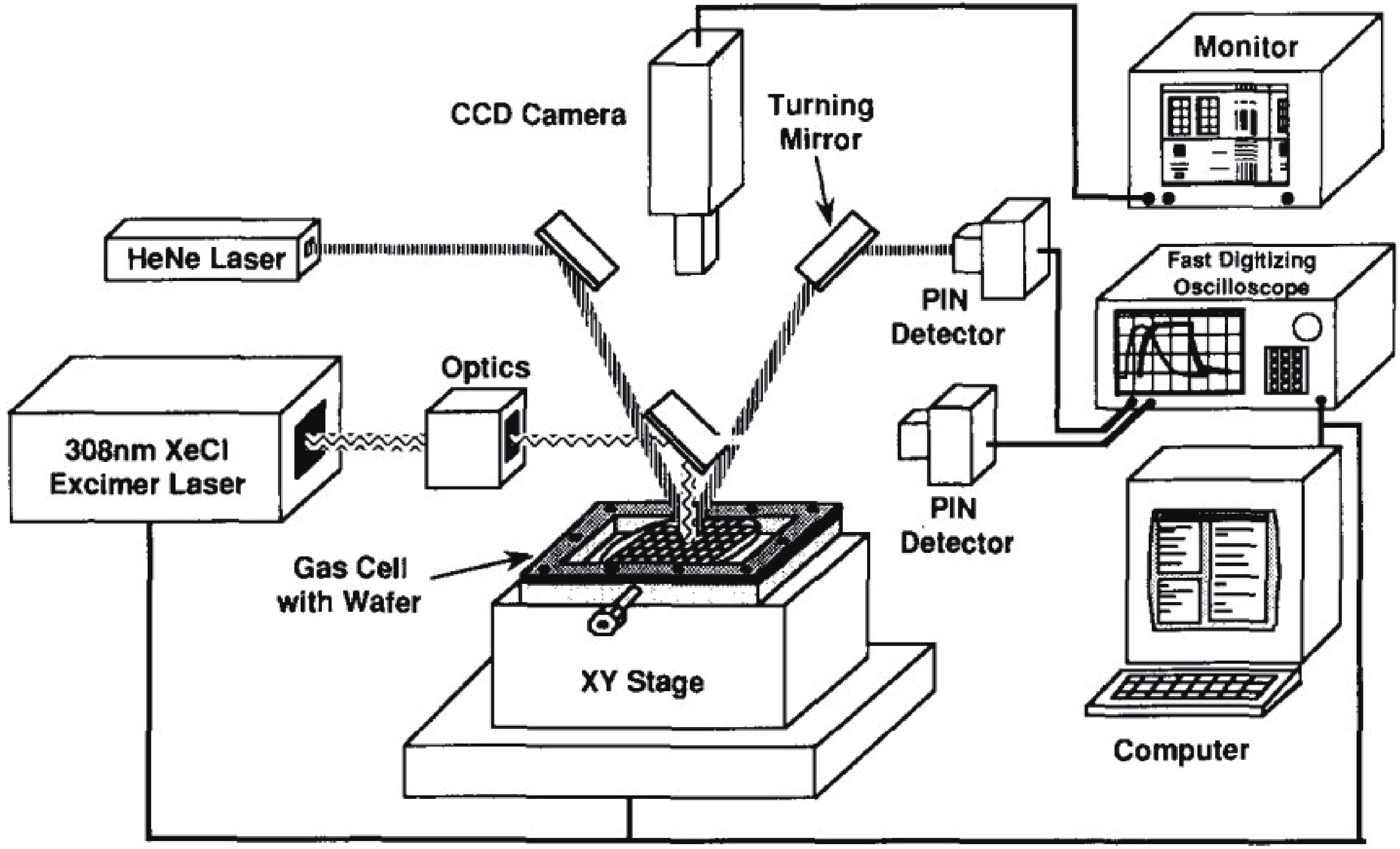
 DownLoad:
DownLoad:
